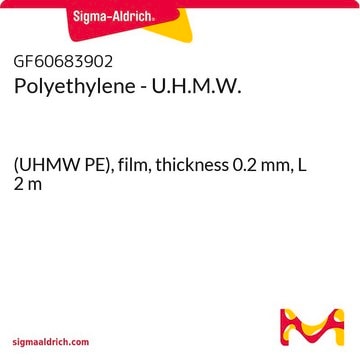434272
Polyethylene
Ultra-high molecular weight, surface-modified, powder, 34-50 μm particle size
Synonym(s):
UHMWPE
Sign Into View Organizational & Contract Pricing
All Photos(3)
About This Item
Linear Formula:
H(CH2CH2)nH
CAS Number:
MDL number:
UNSPSC Code:
12162002
PubChem Substance ID:
NACRES:
NA.23
Recommended Products
form
powder
mol wt
(Ultra-high molecular weight)
particle size
34-50 μm
mp
144 °C
transition temp
Tm (DSC) 144 °C (at peak)
density
0.94 g/mL at 25 °C
InChI
1S/C2H4/c1-2/h1-2H2
InChI key
VGGSQFUCUMXWEO-UHFFFAOYSA-N
Looking for similar products? Visit Product Comparison Guide
Application
Additive to unsaturated polyesters, epoxides and other polymers to impart the unique properties of UHMWPE. Used in industrial parts, coatings and wear surfaces at 10-40 wt. %.
Features and Benefits
Polar surface groups assist chemical and physical bonding to matrix material. Contributes superior abrasion resistance, reduced coefficient of friction, enhanced tear strength and improved moisture resistance. Easier to process in particle form than molten UHMWPE.
Physical form
Particle surface is modified to contain acid and hydroxy groups.
Storage Class Code
11 - Combustible Solids
WGK
WGK 3
Flash Point(F)
Not applicable
Flash Point(C)
Not applicable
Personal Protective Equipment
dust mask type N95 (US), Eyeshields, Gloves
Certificates of Analysis (COA)
Search for Certificates of Analysis (COA) by entering the products Lot/Batch Number. Lot and Batch Numbers can be found on a product’s label following the words ‘Lot’ or ‘Batch’.
Already Own This Product?
Find documentation for the products that you have recently purchased in the Document Library.
Customers Also Viewed
Andrés Felipe Cruz-Pacheco et al.
Polymers, 12(5) (2020-05-23)
Polyaniline (PANI) has recently gained great attention due to its outstanding electrical properties and ease of processability; these characteristics make it ideal for the manufacturing of polymer blends. In this study, the processing and piezoresistive characterization of polymer composites resulting
Ryan M Baxter et al.
Journal of biomedical materials research. Part B, Applied biomaterials, 101(3), 467-475 (2013-02-26)
Despite the widespread implementation of highly cross-linked polyethylene (HXLPE) liners to reduce the clinical incidence of osteolysis, it is not known if the improved wear resistance will outweigh the inflammatory potential of HXLPE wear debris generated in vivo. Thus, we
Morteza Meftah et al.
The Journal of bone and joint surgery. American volume, 95(13), 1193-1197 (2013-07-05)
Ceramic femoral heads produce less wear of the opposing polyethylene than do metal femoral heads in wear simulation studies. This is a matched-pair analysis of the wear of ceramic and metal femoral heads on conventional polyethylene in uncemented total hip
Eliandra Mirlei Rossi et al.
Journal of infection in developing countries, 7(3), 229-234 (2013-03-16)
Contaminated sponges might lead to cross-contamination in kitchens since they can transfer microorganisms to surfaces where microorganisms can survive for hours or days and contaminate food. The main objective of this study was to evaluate the transfer and the survival
S Strieth
HNO, 61(3), 211-216 (2013-03-08)
Although porous polyethylene (PPE) implants are already used in reconstructive craniofacial surgery, they are still only applied in rhinoplasty when critically indicated. Biocompatibility of PPE implants (pore size ~100-200 µm) can be modified by tissue engineering: coatings with extracellular matrix
Our team of scientists has experience in all areas of research including Life Science, Material Science, Chemical Synthesis, Chromatography, Analytical and many others.
Contact Technical Service



